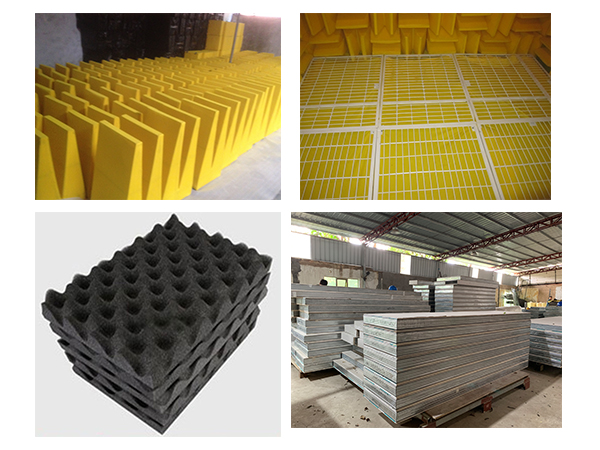Building an anechoic chamber requires the use of a range of special materials designed to reduce the reflection, transmission and penetration of sound, thereby creating a quiet acoustic environment. The following materials are commonly used when constructing anechoic chambers:
Sound-absorbing materials: Sound-absorbing materials are one of the most important materials in an anechoic chamber and are used to reduce sound reflection and resonance. Common sound-absorbing materials include sound-absorbing cotton, foam plastics, fiberglass boards, etc. These materials can reduce sound reflections, reduce resonance in the internal space, and create a gentler acoustic environment. It is common to use these sound-absorbing materials to make acoustic wedges, and install the spikes on six sides to absorb sound, thereby achieving the purpose.
Sound insulation materials: Sound insulation materials are used to prevent the penetration of external noise and ensure the quietness inside the anechoic chamber. Commonly used sound insulation materials include sound insulation panels, sound insulation films, sound insulation mats, etc. These materials have high sound insulation properties and can effectively reduce the transmission of external noise. These are mainly used in some equipment to soundproof some equipment so as not to affect the test results, and to insulate the outside of the anechoic chamber to make the noise inside the anechoic chamber smaller.
Sealing materials: The structure of the anechoic chamber needs to have good sealing properties to prevent sound from penetrating through gaps. Sealing materials are usually used in door gaps, window gaps, etc. in anechoic rooms to ensure the airtightness of the entire space. Common sealing materials include sealing strips, rubber sealing strips, etc.
Soundproof door: The door of the anechoic room needs to have high sound insulation performance to ensure that it can effectively isolate external sounds when closed. Soundproof doors usually adopt a multi-layer structure, with soundproofing materials filled inside and sound-absorbing materials covering the surface to improve the soundproofing effect.
Soundproof windows: If the anechoic room needs to have windows, soundproof windows are essential. Soundproof windows usually use a double- or triple-glazed structure filled with soundproofing material to reduce the spread of sound. At the same time, the window frame also needs to be sealed to ensure that the entire window has good sound insulation performance.
Other accessories materials:
In addition to the concentrated materials mentioned above, other spare parts are also essential, such as ventilation equipment, power distribution systems, lighting tools, soundproof doors and windows, monitoring systems, pneumatic gratings, sensors, etc.
Building an anechoic room requires the use of a series of special materials such as sound-absorbing materials, sound-insulating materials, sealing materials, sound-proof doors, and sound-proof windows. The selection and application of these materials will directly affect the sound insulation effect and acoustic environment quality of the anechoic chamber. Therefore, it is necessary to select carefully when making the anechoic chamber and ensure their reasonable matching and application. Choose a factory with rich experience, use mature technology and materials, and pay attention to details. Only in this way can you build an ideal anechoic chamber.

